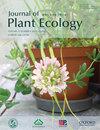Soil hydrological processes as affected by the conversion of natural tropical rainforest to monoculture rubber plantations
IF 3
2区 环境科学与生态学
Q2 ECOLOGY
引用次数: 0
Abstract
Rubber plantations have increased significantly under unprecedented economic growth in tropical areas, which leads to soil degradation and thereby alters soil hydrological processes. However, our understanding of how forest conversion affects soil hydrological processes remains unclear. Here, we collected soil samples from secondary forests (SF) and rubber plantations (RP) to determine the soil hydrological characteristics. We found the topsoil (0–20 cm) water retention in SF was higher than that of RP but displayed the contrast pattern in a deeper soil layer (20–60 cm). Meanwhile, the soil infiltration rates among two vegetation types decreased significantly with infiltration time, with higher stable soil infiltration rates in SF than those in RP. Moreover, soil properties were also impacted by the forest conversion, such as the topsoil capillary porosity and total porosity in SF were higher than those of RP but contrasted in a deep soil layer. In comparison, the topsoil bulk density in SF was lower than that of RP, but contrasted in the deep soil layer and reached a significant level in the 0–10 cm and 40–50 cm (P<0.05). Overall, the soil water retention was mainly determined by the capillary porosity, which could explain 31.56% of total variance in soil water retention, followed by total porosity (26.57%) and soil bulk density (26.47%), whereas soil texture exerts a week effect on soil water retention. Therefore, we can conclude that the conversion of tropical rainforest into rubber plantations may accelerate soil erosion owing to its lower soil water retention and soil infiltration rates.天然热带雨林转变为单一种植橡胶园对土壤水文过程的影响
在热带地区前所未有的经济增长下,橡胶种植园大幅增加,导致土壤退化,从而改变了土壤水文过程。然而,我们对森林转换如何影响土壤水文过程的认识仍不清楚。在此,我们采集了次生林(SF)和橡胶种植园(RP)的土壤样本,以确定土壤的水文特征。我们发现,次生林表层土壤(0-20 厘米)的保水率高于橡胶园,但在更深的土层(20-60 厘米)中,两者的保水率却形成了鲜明的对比。同时,两种植被类型的土壤入渗率随入渗时间的延长而显著降低,其中 SF 的土壤稳定入渗率高于 RP。此外,土壤特性也受到森林改造的影响,如 SF 的表土毛管孔隙度和总孔隙度均高于 RP,但在深土层中则形成鲜明对比。相比之下,SF 的表土容重低于 RP,但在深土层中形成对比,在 0-10 厘米和 40-50 厘米处达到显著水平(P<0.05)。总体而言,土壤保水性主要由毛管孔率决定,毛管孔率可解释土壤保水性总方差的 31.56%,其次是总孔隙度(26.57%)和土壤容重(26.47%),而土壤质地对土壤保水性的影响较小。因此,我们可以得出结论,将热带雨林转化为橡胶种植园可能会加速土壤侵蚀,因为其土壤保水率和土壤渗透率较低。
本文章由计算机程序翻译,如有差异,请以英文原文为准。
求助全文
约1分钟内获得全文
求助全文
来源期刊

Journal of Plant Ecology
生物-植物科学
CiteScore
4.60
自引率
18.50%
发文量
134
审稿时长
3 months
期刊介绍:
Journal of Plant Ecology (JPE) serves as an important medium for ecologists to present research findings and discuss challenging issues in the broad field of plants and their interactions with biotic and abiotic environment. The JPE will cover all aspects of plant ecology, including plant ecophysiology, population ecology, community ecology, ecosystem ecology and landscape ecology as well as conservation ecology, evolutionary ecology, and theoretical ecology.
 求助内容:
求助内容: 应助结果提醒方式:
应助结果提醒方式:


